Anish Kapoor, British(born Bombay, India), 1954-?
Anish Kapoor was born in 1954 in Bombay, India, and moved to London in the early 1970s to study art. Since then he has lived and worked in Britain. Kapoor represented Britain at the Venice Biennale where he won the Premio Duemila, and in 1991 he was awarded the Turner Prize.
Anish Kapoor is one of a generation of internationally acclaimed British artists who came to prominence in the 1980s. He has since developed a distinctive body of work in stone, marble, pigment, stainless steel, and plaster, producing sculptures that can provoke intensely spiritual and physical feelings.
Much of Kapoor's recent work explores the concept of the "void." The artist cuts deeply into the stone, sometimes coating the interior surfaces with a rich pigment and transforming the void into a charged, dark space. Kapoor also works with reflective surfaces that appear to engulf the viewer and his surroundings In 1951, writing on Smooth and Rough, the English art critic Adrian Stokes observed: "Man's greater consciousness implies both an increased fragmentation of experience and a restorative unity: the ego is now stronger, now more split." Anish Kapoor's sculpture seems to apotheosize splitting, even as it suggests, by way of the detour of the spectator reflected in the sculpture, the reintegration of the opposites that result from splitting. The spectator binds the opposites together by way of his or her precarious, ambiguous position. 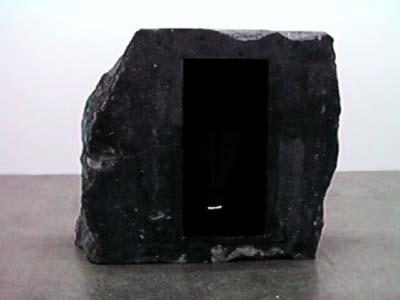
Almost Human, 1998, makes the point clearly. A very smooth, finely polished concave space is scooped out of a monumental block of raw limestone. The concave space seems infinitely deep -- if one looks into its center it seems to become an abyss -- and mirrors the spectator, inverting him or her in the process. The spectator is in effect separated from his or her substance, and becomes pure, precious spectacle. 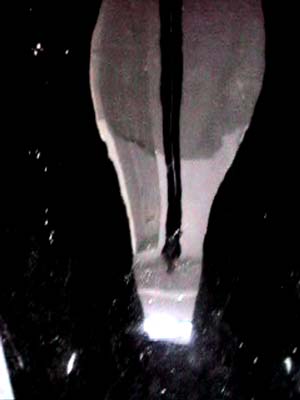
He or she is divided into the same crude physical reality (left in the worldly space outside the sculpture) and refined "transcendental" illusion (within the concave sculptural space) as Kapoor's sculpture. At the same time, the insubstantial, spectacular illusion of the spectator, incorporated into the sculpture -- for an optical illusion is created, in which the spectator seems to be permanently suspended in the concave space, as though his or her appearance is a timeless spiritual revelation in the niche of a church -- restores the stone of the sculpture to a kind of wholeness, however absurd, by filling it in with his or her ironic presence. The stone removed to create the concave space is replaced by spectator after spectator, each taking his or her place in the implied infinity of the mirror's illusionistic space, giving the spectator a kind of sacred aura. The hologram-like illusion of the spectator becomes an icon in abstract space. Thus, precariously eternalized, the passing spectator acquires an ironic durability and memorableness despite his or her greatness, the sign of his or her mortality -- "passing." In becoming ironically immanent in the sculpture, the spectator becomes a transcendent revelation to himself. It is as though he had deliberately willed his transfiguration into pure spirit by the unexpected discovery of his mirror image in the sculpture. 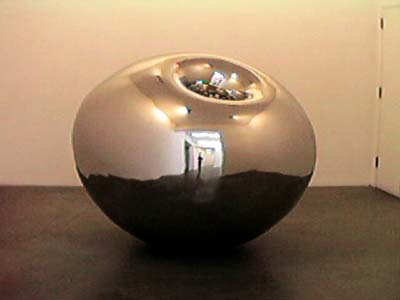
The viewer is also cleverly reflected in the huge stainless steel globes, Turning the World Inside Out, 1995, and Turning the World Upside Down #4, 1998. In an untitled piece built into the wall, the concave space seems to suck the viewer into a pit from which there is no way of climbing out. A grotto-like crevice becomes a vertiginous depth drawing one toward nothingness. Kapoor has said that he "wish[es] to make sculpture ... about experience that is outside material concern," and he has succeeded. 
However, what is striking about the stainless steel sculptures, seen apart from the "transcendentalization" of the spectator, is their vivid materiality, high-tech craft and modernist glorification of geometry, a traditional index of the enduring intelligibility that transcends changing appearances. The limestone piece is also highly crafted, if not overtly high-tech. Yet clearly a great deal of technical knowledge was necessary to give its concave center the luster necessary to turn into a mirror, and a special one at that, for the mirrored spectator remains strongly three-dimensional, creating a hologram-like effect, as I have mentioned. 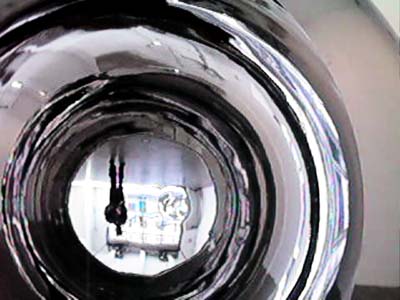
Moreover, the surface of Kapoor's luminous new metal sculptures is colder than that of the lushly colored stone he has used in previous sculptures. The effect is a new remoteness -- a loss of intimacy, for all the ironic intimacy the spectator establishes with the sculpture by way of his or her reflection. Passion is clearly sacrificed for spirituality. The question is whether Kapoor has sublimated to the point of no return to the human condition he claims as his subject matter, as his conceptualization of the wall crevice as a "wound" suggests. 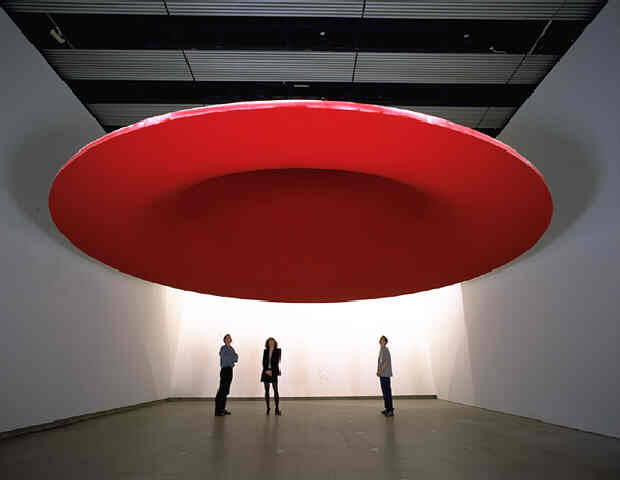
There is a modernist monkishness and purity to the new sculptures that seems altogether at odds with his "humanistic" concern with the spectator. But then the split in his oeuvre between passionate sensuousness and pure spirit signals the strong integrative potential of his ego. It is in the limestone sculpture, simultaneously raw and refined, that he has fine-tuned the tension between the opposites, creating an opportunity for reparative unity
that the ready-made unity of his globes -- the foreordained unity of the circle -- short circuits.
|



